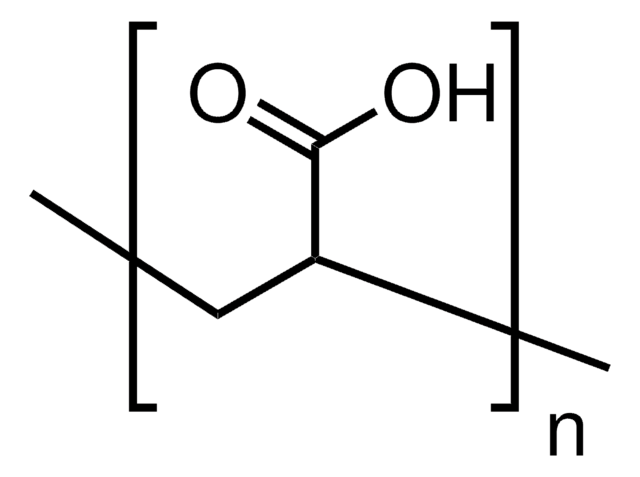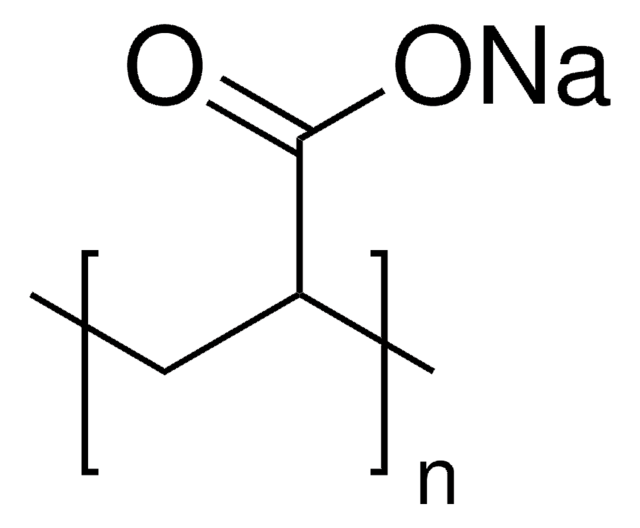Kluczowe dokumenty
436364
Poly(acrylic acid) partial sodium salt
<1000 μm particle size (99%)
Synonim(y):
2-Propenoic acid, sodium salt, polymer with, Acrylic acid-sodium acrylate-1,1,1-trimethylolpropane triacrylate
About This Item
Polecane produkty
Formularz
solid
Poziom jakości
zanieczyszczenia
<600 ppm residual acrylic acid
wielkość cząstki
<1000 μm (99%)
gęstość
0.69 g/mL at 25 °C (lit.)
ciąg SMILES
[Na+].[O-]C(=O)C=C.O(CC(COC(=O)C=C)(COC(=O)C=C)CC)C(=O)C=C.OC(=O)C=C
InChI
1S/C15H20O6.2C3H4O2.Na/c1-5-12(16)19-9-15(8-4,10-20-13(17)6-2)11-21-14(18)7-3;2*1-2-3(4)5;/h5-7H,1-3,8-11H2,4H3;2*2H,1H2,(H,4,5);/q;;;+1/p-1
Klucz InChI
NZZHEJIHHYZFLN-UHFFFAOYSA-M
Powiązane kategorie
Zastosowanie
- Organobentonites modified with poly (acrylic acid) and its sodium salt for foundry applications: This study investigates the interaction between montmorillonite in bentonite and poly(acrylic acid) as well as its sodium salt, focusing on potential uses in foundry applications (S Cukrowicz et al., 2021).
- Temperature and pH-Dependent Response of Poly(Acrylic Acid) and Poly(Acrylic Acid-co-Methyl Acrylate) in Highly Concentrated Potassium Chloride: This research explores the behavior of linear poly(acrylic acid) and its copolymers in response to temperature and pH changes, relevant for various industrial applications (A Sinek et al., 2020).
- Highly sensitive BEHP-co-MEH: PPV+ Poly (acrylic acid) partial sodium salt based relative humidity sensor: Discusses the development of a composite material for humidity sensors, demonstrating the potential of poly(acrylic acid) partial sodium salt in enhancing sensor performance (M Sajid et al., 2017).
- Head-group effect of surfactants of cationic type in interaction with propoxylated sodium salt of polyacrylic acid in aqueous solution: This article examines how different cationic surfactants interact with the sodium salt of polyacrylic acid, providing insights into the molecular dynamics of these mixtures (ZH Asadov et al., 2017).
- Hybrid dual crosslinked polyacrylic acid hydrogels with ultrahigh mechanical strength, toughness and self-healing properties via soaking salt solution: Focuses on the creation of high-performance hydrogels using polyacrylic acid partial sodium salt, aiming for applications that require materials with advanced mechanical properties (X Li et al., 2017).
Hasło ostrzegawcze
Warning
Zwroty wskazujące rodzaj zagrożenia
Zwroty wskazujące środki ostrożności
Klasyfikacja zagrożeń
Eye Irrit. 2 - Skin Irrit. 2 - STOT SE 3
Organy docelowe
Respiratory system
Kod klasy składowania
11 - Combustible Solids
Klasa zagrożenia wodnego (WGK)
WGK 1
Temperatura zapłonu (°F)
Not applicable
Temperatura zapłonu (°C)
Not applicable
Środki ochrony indywidualnej
dust mask type N95 (US), Eyeshields, Gloves
Wybierz jedną z najnowszych wersji:
Masz już ten produkt?
Dokumenty związane z niedawno zakupionymi produktami zostały zamieszczone w Bibliotece dokumentów.
Klienci oglądali również te produkty
Global Trade Item Number
| SKU | GTIN |
|---|---|
| 436364-250G | 4061833598153 |
| 436364-1KG | 4061832115757 |
Nasz zespół naukowców ma doświadczenie we wszystkich obszarach badań, w tym w naukach przyrodniczych, materiałoznawstwie, syntezie chemicznej, chromatografii, analityce i wielu innych dziedzinach.
Skontaktuj się z zespołem ds. pomocy technicznej




